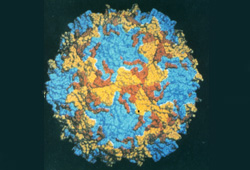Summary
Definition
History and exam
Key diagnostic factors
- unimmunized status
- residence or travel in endemic area
- decreased tone and motor function of affected limb
- decreased tendon reflexes of affected limb
- muscle atrophy of affected limb
Other diagnostic factors
- age <36 months
- gastrointestinal prodrome
- fever
- malaise
- respiratory muscle atrophy and respiratory distress
Risk factors
- lack of vaccination
- poor sanitation
- poverty
- area of endemic infection
- immunosuppression
Diagnostic tests
გასათვალისწინებელი კვლევები
- virus culture from stool, CSF, or pharynx
- PCR plus sequencing
- CSF analysis
- serum antibodies to poliovirus
- MRI of spinal cord
- electromyelogram (EMG) of affected limb
მკურნალობის ალგორითმი
კონტრიბუტორები
ავტორები
Omar A. Khan, MD, MHS, FAAFP

President and CEO
Delaware Health Sciences Alliance
Physician Leader, Partnerships & Academic Programs
Christiana Care Health System
Associate Professor
Department of Family & Community Medicine
Sidney Kimmel Medical College of Thomas Jefferson University
Newark
DE
გაფრთხილება:
OAK is an author of a number of references cited in this topic.
David L. Heymann, MD, DTM&H
Professor of Infectious Disease Epidemiology
London School of Hygiene and Tropical Medicine
University of London
Head
Centre on Global Health Security - Chatham House
London
UK
გაფრთხილება:
DLH is an author of a number of references cited in this topic.
რეცენზენტები
Javed M. Gilani, MD, FRCP, FACP
Assistant Clinical Professor
Jefferson Medical College
Philadelphia
PA
გაფრთხილება:
JMG declares that he has no competing interests.
Gregory Pappas, MD, PhD
The Nordin M. Thobani Professor and Chairman
Department of Community Health Sciences
Aga Khan University
Karachi
Pakistan
გაფრთხილება:
GP declares that he has no competing interests.
რეცენზენტების განცხადებები
BMJ Best Practice-ის თემების განახლება სხვადასხვა პერიოდულობით ხდება მტკიცებულებებისა და რეკომენდაციების განვითარების შესაბამისად. ქვემოთ ჩამოთვლილმა რეცენზენტებმა თემის არსებობის მანძილზე კონტენტს ერთხელ მაინც გადახედეს.
გაფრთხილება
რეცენზენტების აფილიაციები და გაფრთხილებები მოცემულია გადახედვის მომენტისთვის.
წყაროები
ძირითადი სტატიები
Heymann DL, Aylward RB. Eradicating polio. N Engl J Med. 2004 Sep 23;351(13):1275-7. აბსტრაქტი
Global Polio Eradication Initiative. GPEI Strategy 2022-2026. 2021 [internet publication].სრული ტექსტი
Farbu E, Gilhus NE, Barnes MP, et al. Post-polio syndrome: EFNS guidelines on post-polio syndrome. In: Gilhus NE, Barnes MP, Brainin M, eds. European Handbook of Neurological Management, Volume 1. 2nd ed. West Sussex, UK: Blackwell Publishing Ltd.; 2011:311-9.
Centers for Disease Control and Prevention. Polio: polio vaccination for international travelers. Jul 2024 [internet publication].სრული ტექსტი
გამოყენებული სტატიები
ამ თემაში მოხსენიებული წყაროების სრული სია ხელმისაწვდომია აქ.
内容使用需遵循免责声明

